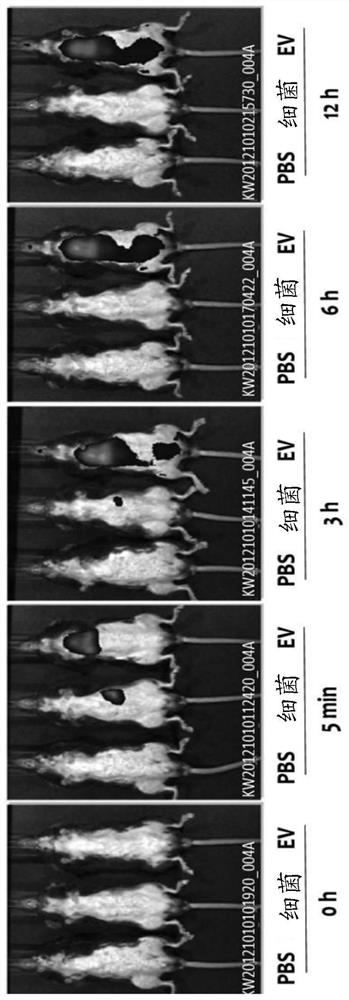Nanovesicles derived from coprococcus sp. bacteria, and use thereof
A technology of Coprolococcus and vesicles, which is applied in the field of bacterial nanovesicles and its applications, and can solve the problems of unreported Coprococcus bacteria secreting vesicles, unreported diagnosis and treatment of refractory diseases, etc.
- Summary
- Abstract
- Description
- Claims
- Application Information
AI Technical Summary
Problems solved by technology
Method used
Image
Examples
Embodiment 1
[0083] Example 1. Analysis of In vivo Absorption, Distribution and Excretion Patterns of Gut Bacteria and Bacteria-Derived Vesicles
[0084] To assess whether gut bacteria and bacterial-derived vesicles are absorbed systemically through the gastrointestinal tract, the following experiments were performed. First, a dose of 50 μg of each of the fluorescently labeled intestinal bacteria and the vesicles derived from intestinal bacteria was administered to the stomach of the mouse through the gastrointestinal tract, and at 0 minutes, 5 minutes, 3 hours, and 6 hours and measure fluorescence after 12 hours. As a result of observing the whole image of the mouse, as Figure 1A As shown, bacteria were not taken up systemically, but vesicles derived from bacteria were absorbed systemically at 5 minutes after administration, and strong fluorescence was observed in the bladder at 3 hours after administration, thus showing that the vesicles were excreted to the urinary tract. Furthermo...
Embodiment 2
[0086] Example 2. Metagenomic analysis of bacterial-derived vesicles in clinical samples
[0087]After the blood was first placed in a 10 ml tube and the suspension was settled by centrifugation (3,500 xg, 10 min, 4°C), only the supernatant was transferred to a new 10 ml tube. After removing bacteria and impurities using a 0.22-μm filter, transfer them to a Centriprep tube (centrifugal filter 50kD) and centrifuge at 1,500×g and 4°C for 15 minutes, discard the material smaller than 50kD, and the residue Concentrate to 10ml. After bacteria and impurities were removed again using a 0.22-μm filter, supernatant was discarded and aggregated pellets were dissolved by performing ultracentrifugation at 150,000×g and 4°C for 3 hours using a 90Ti type rotor in normal saline (PBS).
[0088] 100 μl of vesicles isolated by the method described above were boiled at 100 °C to extract internal DNA from lipids, and then cooled on ice for 5 min. Then, in order to remove the residual suspens...
Embodiment 3
[0092] Example 3. Metagenomic analysis of bacterial-derived vesicles in the blood of breast cancer patients
[0093] Genes were extracted from the vesicles present in the blood of 96 breast cancer patients and 192 normal individuals (both groups were matched in age and sex), and after using the method in Example 2 to perform metagenomic analysis on the blood, the source The distribution of vesicles in Coprolococcus bacteria was assessed. As a result, it was confirmed that vesicles derived from bacteria of the genus Faecalis were significantly reduced in blood from breast cancer patients compared with blood from normal individuals (see Table 2 and Table 2). figure 2 ).
[0094] [Table 2]
[0095]
PUM
| Property | Measurement | Unit |
|---|---|---|
| diameter | aaaaa | aaaaa |
| absorbance | aaaaa | aaaaa |
Abstract
Description
Claims
Application Information
 Login to View More
Login to View More - R&D
- Intellectual Property
- Life Sciences
- Materials
- Tech Scout
- Unparalleled Data Quality
- Higher Quality Content
- 60% Fewer Hallucinations
Browse by: Latest US Patents, China's latest patents, Technical Efficacy Thesaurus, Application Domain, Technology Topic, Popular Technical Reports.
© 2025 PatSnap. All rights reserved.Legal|Privacy policy|Modern Slavery Act Transparency Statement|Sitemap|About US| Contact US: help@patsnap.com



